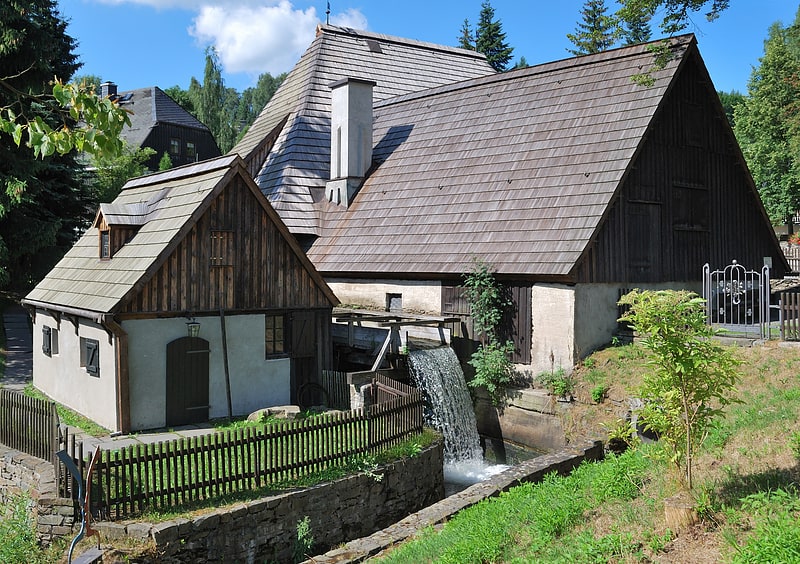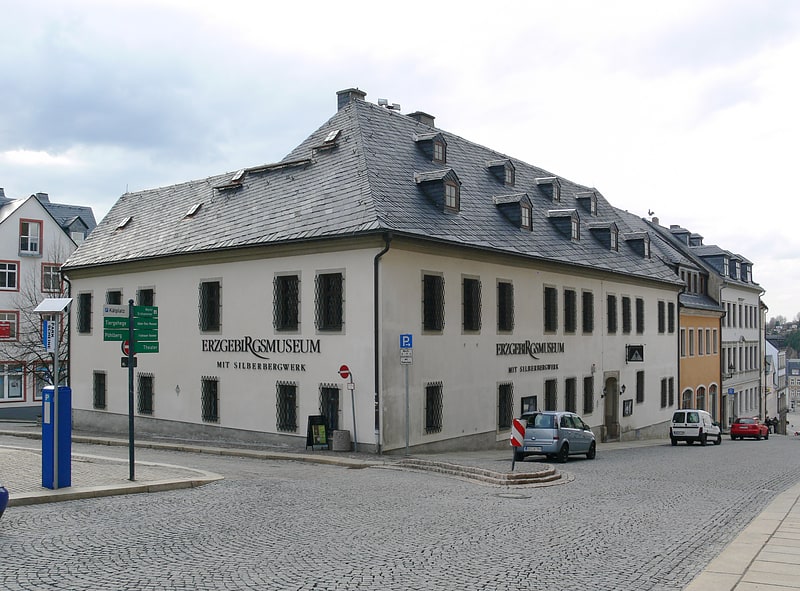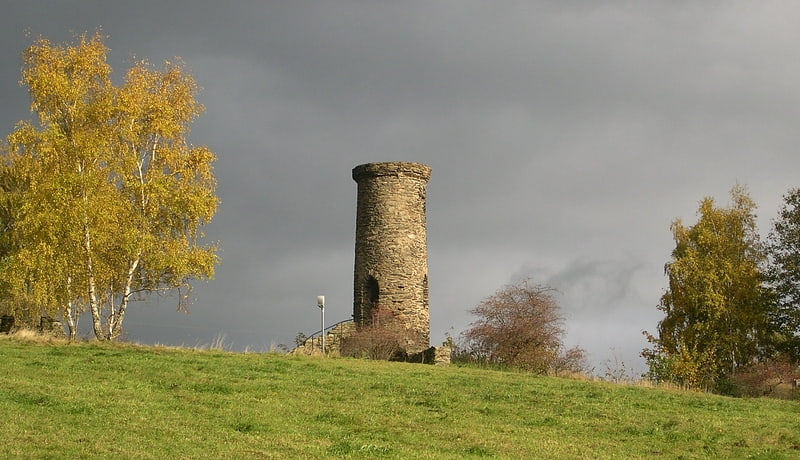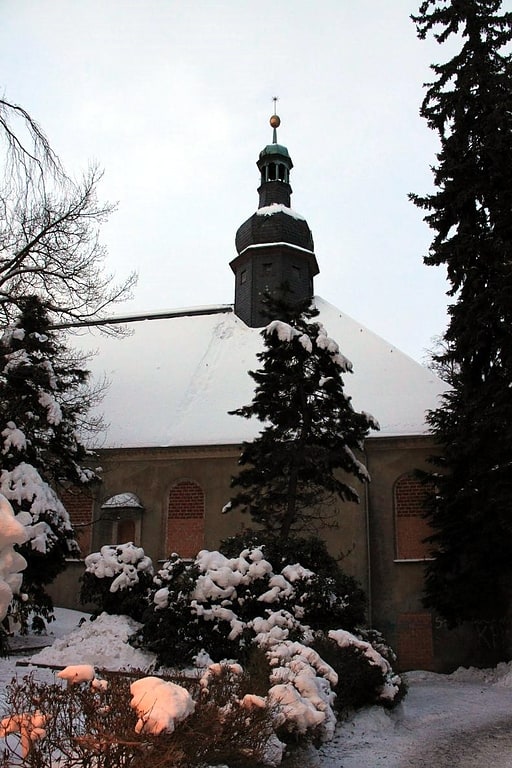Discover 8 hidden attractions, cool sights, and unusual things to do in Annaberg-Buchholz (Germany). Don't miss out on these must-see attractions: Frohnauer Hammer, Erzgebirgsmuseum, and St. Annenkirche. Also, be sure to include Ore Mountains in your itinerary.
Below, you can find the list of the most amazing places you should visit in Annaberg-Buchholz (Saxony).
Table of Contents
Frohnauer Hammer

Museum in Annaberg-Buchholz, Germany. The Frohnauer Hammer is an historic hammer mill in Frohnau, a village in the municipality of Annaberg-Buchholz in the Ore Mountains of southeast Germany. The mill is an important witness to proto-industrial development in the Ore Mountains. Of the once-numerous hammer mills only three others remain working in Saxony: the Dorfchemnitz Iron Hammer Mill, the Grünthal Copper Hammer Mill and the Freibergsdorf Hammer Mill.
In 1907 the Frohnauer Hammer Mill on the Sehma river became the first technical monument in Saxony. The museum complex includes the hammer mill itself, an exhibition of forged artefacts, a hand forge, a mechanical "Christmas hill" (Weihnachtsberg) and a bobbin lace room.[1]
Address: Sehmatalstraße 3, 09456 Annaberg-Buchholz
Erzgebirgsmuseum

Museum in Annaberg-Buchholz, Germany. The Ore Mountain Museum is a museum in Annaberg-Buchholz in the German state of Saxony and located in the Ore Mountains of Central Europe. Its display includes examples of Ore Mountain folk art, especially carvings, bobbin work and passements) and gives an insight into the history of the town of Annaberg and of silver mining in the region. The museum also owns a work from the workshop of Lucas Cranach the Younger from 1572 and a large collection of valuable pewter vessels. Adjoining the museum is the visitor mine of Im Gößner.[2]
Address: Große Kirchgasse 16, 09456 Annaberg-Buchholz
St. Annenkirche

Church in Annaberg-Buchholz, Germany. St. Anne's Church in Annaberg-Buchholz, German Free State of Saxony, is a hall church whose architectural style is on the boundary between the Late Gothic and Renaissance. With a length of 65 metres and width of 40 metres, it is the largest, true hall church of the Late Gothic in Saxony. Its tower is 78 metres high, the interior of the church 28 metres high. It is the emblem of the town and visible from a long way off. Saint Anne's was originally built in 1499 as a Roman Catholic church, but became Lutheran in 1539.[3]
Address: Große Kirchgasse 21, 09456 Annaberg-Buchholz
Ore Mountains

Also known as: Erzgebirge
Natural region in Germany. The Ore Mountains lie along the Czech–German border, separating the historical regions of Bohemia in Czech Republic and Saxony in Germany. The highest peaks are the Klínovec in the Czech Republic, which rises to 1,244 metres above sea level and the Fichtelberg in Germany.
The area played an important role in contributing Bronze Age ore and, since the first wave of settlement in the Middle Ages, the nature of the Ore Mountains has been intensively shaped by human intervention and has created a diverse cultural landscape. In particular, mining with its tips, dams, ditches and sinkholes directly shaped the landscape and the habitats of plants and animals in many places. The region was also the setting of the earliest stages of the early modern transformation of mining and metallurgy from a craft to a large-scale industry, a process that preceded and enabled the later Industrial Revolution.
The higher altitudes from around 500 m above sea level on the German side belong to the Ore Mountains/Vogtland Nature Park – the largest of its kind in Germany with a length of 120 km. The eastern Ore Mountains are protected landscape. Other smaller areas on the German and Czech side are protected as nature reserves and natural monuments. On the ridges there are also several larger raised bogs that are only fed by rainwater. The mountains are popular for hiking and there are winter sports areas at higher elevations. In 2019, the region became a UNESCO World Heritage Site.[4]
Schreckenberg

Mountain in Germany. Schreckenberg is a mountain of Saxony, southeastern Germany.[5]
Frohnau

Village in Germany. Frohnau is a village in the Saxon town of Annaberg-Buchholz in the district of Erzgebirgskreis in southeast Germany. The discovery of silver on the Schreckenberg led in 1496 to the foundation of the neighbouring mining town of Annaberg. The village of Frohnau is best known for its museum of technology, the Frohnauer Hammer, and the visitor mine of Markus Röhling Stolln. The mining area around Frohnau has been selected as a candidate for a UNESCO World Heritage Site: the Ore Mountain Mining Region.[6]
Church of the Holy Trinity

The Hospitalkirche St. Trinitatis in Annaberg is a classicist hall church in the Saxon Erzgebirge. The church was built on the site of the previous building in front of the former Wolkensteiner Tor, which burned down in 1826 and formed a complex with the hospital and the town churchyard. The church, which has been empty for a long time, is to become a center for contemporary art. The pilgrimage to St. Trinitatis, which started in 1519, developed into the Kät, the largest folk festival in the Ore Mountains.
Ruine Schreckenberg

Forts and castles